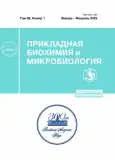New Inhibitors of Pancreatic α-amylase from Rhaponticum uniflorum
- 作者: Olennikov D.N.1, Kashchenko N.I.1
-
隶属关系:
- Institute of General and Experimental Biology SD RAS
- 期: 卷 59, 编号 1 (2023)
- 页面: 46-55
- 栏目: Articles
- URL: https://journals.rcsi.science/0555-1099/article/view/138740
- DOI: https://doi.org/10.31857/S0555109923010063
- EDN: https://elibrary.ru/CUYJJV
- ID: 138740
如何引用文章
全文:
详细
The basic strategy for the treatment of diabetes mellitus is the control of postprandial glucose levels, and therefore pancreatic α-amylase that hydrolyzes complex carbohydrates is an important enzymatic target for the scientific research. In the present study, an aqueous extract and its ethyl acetate fraction (EAF) from the seeds of Rhaponticum uniflorum had a pronounced inhibitory effect on the activity of human pancreatic α-amylase. Sixteen metabolites were isolated after the chromatographic separation of EAF and characterized as 4-O-, 5-O-, 3,4-di-O-, 3,5-di-O-, 4,5-di-O-caffeoylquinic acid, 6-hydroxyluteolin 7-O-glucoside, rhaunoside B, luteolin 7-O-(6"-O-caffeoyl)-glucoside, luteolin, carthamoside, carthamogenin, tracheloside, isoferuloyl-serotonin, 20-hydroxyecdysone, 2-deoxy-20-hydroxyecdysone and a new natural compound, which was carthamogenin 4-O-(6''-O-acetyl)-β-D-glucopyranoside (6''-O-acetyl-cartamoside). Quantitative HPLC data indicated a different distribution of the individual components between the endosperm and the seed coat. The study of the compounds effect on the activity of human pancreatic α-amylase showed that some flavonoids, caffeoylquinic acids, lignans and serotonin derivatives had a pronounced inhibitory effect. These results support the conclusion that Rhaponticum uniflorum seeds may be a useful natural source for the development of α-amylase inhibitory agents.
作者简介
D. Olennikov
Institute of General and Experimental Biology SD RAS
编辑信件的主要联系方式.
Email: olennikovdn@mail.ru
Russia, 670047, Ulan-Ude
N. Kashchenko
Institute of General and Experimental Biology SD RAS
Email: olennikovdn@mail.ru
Russia, 670047, Ulan-Ude
参考
- Alam S., Sarker M.M.R., Sultana T.N., Chowdhury M.N.R., Rashid M.A., Chaity N.I. et al. // Front. Endocrinol. 2022. V. 13. № 800714. https://doi.org/10.3389/fendo.2022.800714
- Sales P.M., Souza P.M., Simeoni L.A., Magalhães P.O., Silveira D. // J. Pharm. Pharm. Sci. 2009. V. 15. P. 141–183. https://doi.org/10.18433/j35s3k
- Баторова С.М., Яковлев Г.П., Асеева Т.А. Справочник лекарственных растений традиционной тибетской медицины. Новосибирск: Наука, 2003. 291 с.
- Olennikov D.N., Kashchenko N.I. // Chem. Nat. Comp. 2019. V. 55. P. 256–264. https://doi.org/10.1007/s10600-019-02662-2
- Olennikov D.N. // Chem. Nat. Comp. 2018. V. 54. P. 751–754. https://doi.org/10.1007/s10600-018-2462-4
- Olennikov D.N. // Chem. Nat. Comp. 2019. V. 55. P. 157–159. https://doi.org/10.1007/s10600-019-02642-6
- Shantanova L.N., Olennikov D.N., Matkhanov I.E., Gulyaev S.M., Toropova A.A., Nikolaeva I.G., Nikolaev S.M. // Pharmaceuticals. 2021. V. 14. № 1186. https://doi.org/10.3390/ph14111186
- Olennikov D.N., Chemposov V.V., Chirikova N.K. // Plants. 2021. V. 10. № 2525. https://doi.org/10.3390/plants10112525
- Harmatha J., Buděšínský M., Vokáč K., Pavlik M., Grüner K., Laudová V. // Collect. Czech. Chem. Commun. 2007. V. 72. P. 334–346. https://doi.org/10.1135/cccc20070334
- Olennikov D.N., Chirikova N.K., Kashchenko N.I., Gornostai T.G., Selyutina I.Y., Zilfikarov I.N. // Int. J. Mol. Sci. 2017. V. 18. № 2579. https://doi.org/10.3390/ijms18122579
- Akabane M., Yamamoto A., Aizawa S., Taga A., Kodama S. // Analyt. Sci. 2014. V. 30. P. 739–743. https://doi.org/10.2116/analsci.30.739
- Olennikov D.N., Chirikova N.K. // Chem. Nat. Comp. 2019. V. 55. P. 1032–1038. https://doi.org/10.1007/s10600-019-02887-1
- Olennikov D.N., Chirikova N.K., Kashchenko N.I., Nikolaev V.M., Kim S.-W., Vennos C. // Front. Pharmacol. 2018. V. 9. № 756. https://doi.org/10.3389/fphar.2018.00756
- Sólyomváry A., Mervai Z., Molnár-Perl I., Boldizsár I. // Nat. Prod. Res. 2014. V. 28. P. 732–739. https://doi.org/10.1080/14786419.2013.879473
- Tadera K., Minami Y., Takamatsu K., Matsuoka T. // J. Nutr. Sci. Vitaminol. 2006. V. 52. P. 149–153. https://doi.org/10.3177/jnsv.52.149
- Dandekar P.D., Kotmale A.S., Chavan S.R., Kadlag P.P., Sawant S.V., Dhavale D.D., Kumar A.R. // ACS Omega. 2021. V. 6. P. 1780–1786. https://doi.org/10.1021/acsomega.0c00617
- Ponnusamy S., Zinjarde S., Bhargava S., Rajamohanan P.R., Ravikumar A. // Food Chem. 2012. V. 135. P. 2638–2642. https://doi.org/10.1016/j.foodchem.2012.06.110
- García A.L.L., Olaya M.Q.J.H., Sierra A.J.I. // Rev. Cubana Plant. Med. 2017. V. 22. P. 1–14.
- Cansian R.L., Vanin A.B., Orlando T., Piazza S.P., Puton B.M.S., Cardoso R.I. et al. // Braz. J. Biol. 2017. V. 77. P. 155–161. https://doi.org/10.1590/1519-6984.12215
- Yamasaki T., Sato M., Mori T., Mohamed A.S.A., Fujii K., Tsukioka J. // J. Nat. Toxins. 2002. V. 11. P. 165–171.












